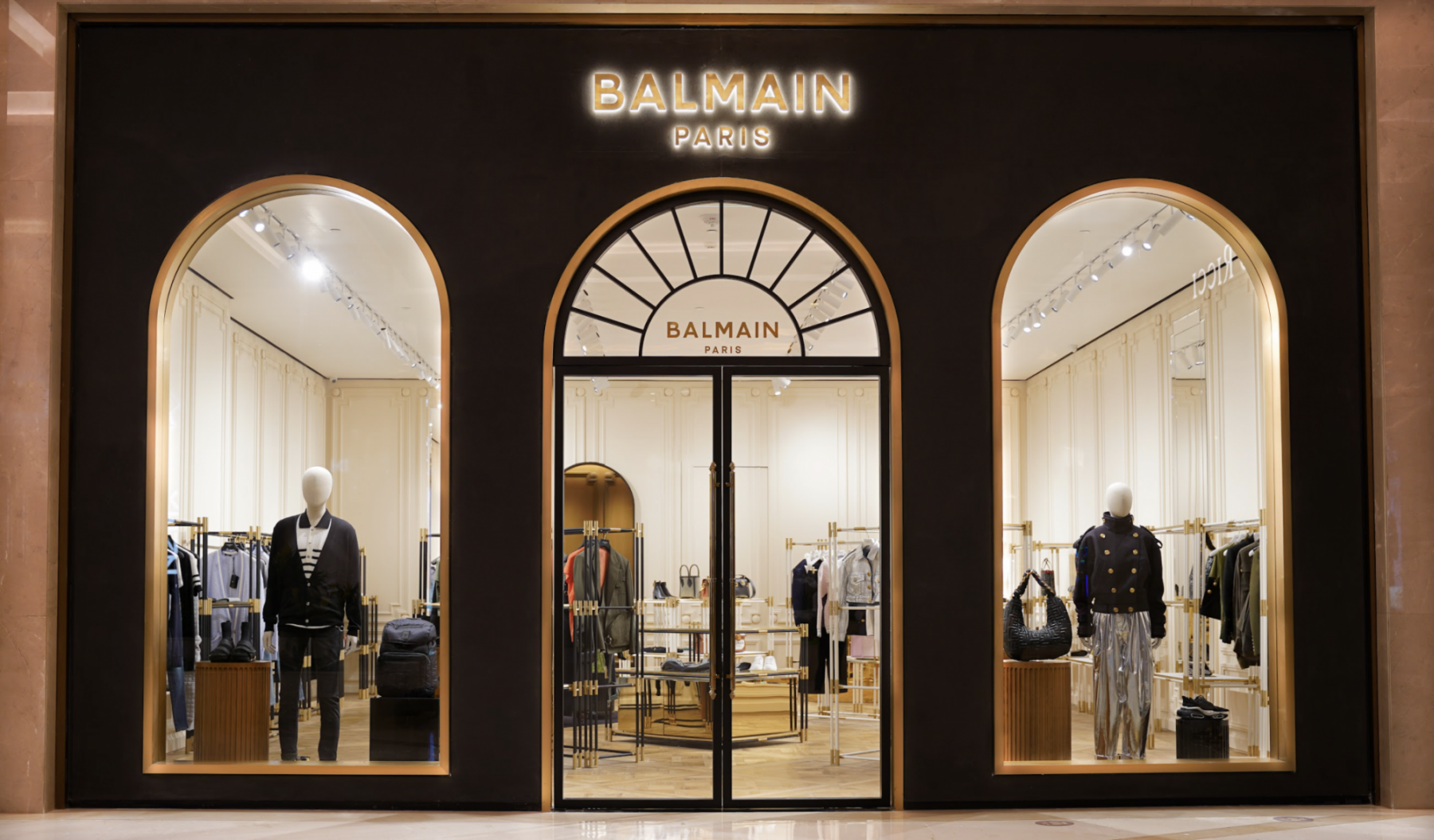Balmain is a prestigious luxury fashion brand that was established in 1945 by Pierre Balmain, a French fashion designer. It quickly gained recognition for its elegant and opulent designs, which played a significant role in shaping the post-World War II fashion landscape. Pierre Balmain’s vision was to create clothing that exuded sophistication, glamour, and femininity.
Balmain’s early designs were characterized by their refined tailoring and intricate detailing. The brand became known for its emphasis on craftsmanship, with a focus on creating impeccably constructed garments using the finest materials. Balmain’s aesthetic was influenced by the couture tradition of Paris, combining classic elegance with a modern sensibility.
During the 1950s and 1960s, Balmain became a favorite among the high society and Hollywood elite. The brand’s exquisite evening gowns and cocktail dresses adorned celebrities such as Sophia Loren, Marlene Dietrich, and Audrey Hepburn, cementing Balmain’s reputation as a symbol of luxury and sophistication.
Following Pierre Balmain’s death in 1982, the brand experienced a series of creative directors who each added their own touch to the Balmain aesthetic. Notably, Oscar de la Renta, who took over the house in the 1990s, maintained the brand’s emphasis on elegance and femininity.
However, it was under the creative direction of Olivier Rousteing, who joined Balmain in 2009, that the brand experienced a revitalization and garnered significant attention. Rousteing injected a new energy into the brand, infusing it with a modern and edgy aesthetic. His designs featured bold embellishments, strong shoulders, and body-conscious silhouettes, appealing to a younger generation and catapulting Balmain to new heights of popularity.
Rousteing’s designs embraced the power of social media, leveraging celebrities and influencers as brand ambassadors. Balmain became a favorite on red carpets, with celebrities like Kim Kardashian, Beyoncé, and Rihanna frequently seen wearing Balmain creations. This exposure further solidified Balmain’s status as a coveted luxury brand with a strong presence in popular culture.
The brand’s success has extended beyond clothing. Balmain has diversified its product offerings, including accessories like shoes, handbags, and eyewear. It has also ventured into fragrances, releasing perfumes that embody the brand’s luxurious and sensual spirit.
In addition to its main fashion line, Balmain has also collaborated with other brands to bring its designs to a wider audience. Notably, the collaboration with H&M in 2015 created a frenzy, with Balmain’s high-fashion aesthetic made accessible to a broader consumer base.
Overall, Balmain has established itself as a synonymous with luxury, craftsmanship, and glamour. Its designs continue to push boundaries and captivate fashion enthusiasts worldwide, making it one of the most iconic and influential fashion brands of our time.
Marketing Strategies of Balmain
Balmain has captivated the industry with its exquisite designs and strong brand presence. Behind its success lies a meticulously crafted marketing strategy that effectively communicates the brand’s essence of opulence, glamour, and modernity. In this part, we delve into the key marketing strategies employed by Balmain to create an enduring and coveted brand image.
Collaborations with Influencers and Celebrities: One of Balmain’s notable marketing strategies is its collaborations with influencers and celebrities. By partnering with high-profile individuals, Balmain gains exposure to their extensive fan bases and benefits from the association with their influential status. Celebrities like Kim Kardashian, Beyoncé, and Rihanna have been spotted wearing Balmain designs, creating a buzz and generating widespread media coverage. These collaborations have helped Balmain reach a wider audience and enhance its desirability among fashion enthusiasts.
Leveraging Social Media: Balmain has adeptly harnessed the power of social media to connect with its target audience. The brand maintains an active presence on popular platforms like Instagram, Twitter, and Facebook, showcasing its latest collections, behind-the-scenes footage, and collaborations. Balmain strategically uses visually striking content, including high-quality imagery and videos, to engage and inspire its followers. The brand’s social media strategy effectively cultivates an aspirational lifestyle associated with Balmain, keeping the brand top of mind and fostering a sense of exclusivity.
Red Carpet and Celebrity Endorsements: Balmain strategically dresses celebrities for red carpet events, award ceremonies, and high-profile occasions. The brand’s presence on influential red carpets provides valuable visibility and generates media attention. The choice of dressing A-list celebrities helps position Balmain as a go-to brand for glamorous and statement-making fashion. This strategy creates a strong association between Balmain and celebrity culture, elevating its brand image and increasing desirability.
Couture Shows and Fashion Events: Balmain’s grandiose couture shows and participation in renowned fashion events contribute to its marketing success. The brand’s runway presentations are highly anticipated, creating buzz and excitement within the fashion industry. Balmain meticulously orchestrates these events, ensuring they reflect the brand’s aesthetic and capture the attention of the press, influencers, and potential customers. By showcasing its creativity and craftsmanship, Balmain reinforces its position as a luxury fashion powerhouse.
Strategic Collaborations: Balmain has strategically collaborated with other brands to expand its reach and tap into new markets. The collaboration with H&M in 2015, for instance, brought Balmain’s high-fashion designs to a wider consumer base at more accessible price points. These collaborations generate excitement and anticipation, attracting both loyal Balmain customers and new audiences seeking a taste of luxury.
Storytelling and Brand Identity: Balmain’s marketing strategy emphasizes storytelling and brand identity. The brand consistently communicates its heritage, craftsmanship, and vision through various marketing channels. Balmain highlights its legacy as a prestigious fashion house while embracing contemporary elements that resonate with the current fashion landscape. This fusion of tradition and innovation helps Balmain maintain relevance and build a strong brand identity that consumers can connect with.
Balmain’s marketing strategies have played a pivotal role in establishing its prominence as a luxury fashion brand. Through collaborations, social media engagement, celebrity endorsements, high-profile events, and strategic partnerships, Balmain has successfully crafted a brand image that exudes glamour, exclusivity, and modernity. By leveraging these marketing strategies, Balmain continues to captivate the industry and maintain its position as a sought-after name in the world of luxury fashion.
Marketing Mix of Balmain
Balmain has consistently impressed the industry with its captivating designs and strong brand presence. Behind its success lies a well-crafted marketing mix that integrates key elements to effectively position and promote the brand. In this article, we explore the marketing mix of Balmain, analyzing how the brand utilizes product, price, place, and promotion strategies to solidify its status in the competitive fashion market.
Product Strategy: Balmain’s product strategy revolves around creating high-quality, luxurious fashion items that epitomize elegance, opulence, and innovation. The brand offers a diverse range of products, including ready-to-wear collections, couture pieces, accessories, footwear, and fragrances. Balmain’s designs are characterized by impeccable craftsmanship, intricate detailing, and distinctive silhouettes that appeal to fashion enthusiasts seeking exclusive and statement-making pieces. The brand consistently strives to deliver exceptional products that reflect its signature aesthetic and meet the discerning expectations of its target market.
Price Strategy: Balmain positions itself as a luxury fashion brand, commanding premium pricing for its products. The brand leverages its prestigious reputation, craftsmanship, and the perceived value of its designs to justify the higher price points. Balmain’s pricing strategy caters to an affluent customer segment that appreciates and is willing to invest in high-quality, exclusive fashion pieces. While the brand’s mainline collections are priced at a luxury level, Balmain has also utilized collaborations, like the H&M partnership, to introduce more accessible price points, expanding its reach to a broader consumer base.
Place Strategy: Balmain strategically selects its distribution channels to maintain a sense of exclusivity and ensure alignment with its brand image. The brand operates flagship stores in prestigious fashion capitals such as Paris, New York, and London, where customers can experience the brand’s immersive retail environments. Balmain also maintains a strong presence in upscale department stores and luxury multi-brand boutiques globally. Additionally, Balmain has expanded its online presence, offering e-commerce platforms to cater to a wider audience and capitalize on the convenience of online shopping.
Promotion Strategy: Balmain’s promotion strategy employs various tactics to generate buzz, create brand awareness, and engage its target audience. The brand actively collaborates with influential celebrities and partners with fashion magazines, aligning itself with the world of celebrity culture and high-profile events. Balmain leverages social media platforms, particularly Instagram, to showcase its collections, behind-the-scenes content, and collaborations. The brand’s visually appealing posts, influencer partnerships, and strategic hashtag campaigns help it reach a global audience and foster a strong online community. Balmain’s participation in fashion shows, industry events, and media campaigns further solidifies its brand presence and positions it as a key player in the fashion landscape.
People and Experience: Balmain recognizes the importance of providing exceptional customer service and a memorable shopping experience. The brand invests in knowledgeable and well-trained staff to assist customers in its physical stores, ensuring a personalized and luxurious encounter. Balmain’s flagship stores are designed to reflect the brand’s aesthetic, with carefully curated interiors and attention to detail. The brand strives to create a sense of exclusivity and sophistication, further enhancing the overall customer experience.
Balmain’s success can be attributed, in part, to its effective marketing mix. By focusing on product excellence, premium pricing, selective distribution, impactful promotion, and creating exceptional customer experiences, Balmain has firmly established itself as a leading luxury fashion brand. The brand’s meticulous attention to every element of the marketing mix allows it to consistently deliver on its promise of glamour, exclusivity, and innovation, captivating fashion enthusiasts and maintaining its prominent position in the competitive industry.
Unveiling the STP Analysis of Balmain: A Comprehensive Evaluation
Balmain has gained global recognition for its opulent designs and glamorous aesthetic. Behind its success lies a well-executed segmentation, targeting, and positioning (STP) strategy. In this article, we delve into the STP analysis of Balmain, examining how the brand identifies customer segments, targets specific markets, and positions itself to stand out in the competitive fashion industry.
Segmentation: Balmain employs various segmentation strategies to identify distinct customer groups. The brand recognizes that its target market consists of individuals who value luxury, exclusivity, and high-quality fashion. Balmain’s segmentation can be analyzed based on several factors:
a) Demographic Segmentation: Balmain caters to affluent individuals, both men and women, typically aged 25-45, who have a taste for luxury fashion and appreciate the brand’s unique aesthetic.
b) Psychographic Segmentation: Balmain targets fashion-forward individuals who aspire to make bold statements through their clothing choices. These customers are confident, trend-conscious, and seek exclusivity in their fashion selections.
c) Geographic Segmentation: Balmain’s target market is not confined to a specific geographic region. The brand has a global appeal and attracts customers from fashion capitals worldwide.
Targeting: Balmain employs a concentrated targeting strategy, focusing on capturing the attention and loyalty of its identified customer segments. By honing in on a specific target market, Balmain can better understand their needs, preferences, and purchasing behaviors. The brand strategically tailors its product offerings and marketing efforts to cater to the desires of its target audience. Balmain’s target market includes high-net-worth individuals, fashion enthusiasts, celebrities, and social influencers who appreciate the brand’s distinctive style and are willing to invest in luxury fashion.
Positioning: Balmain positions itself as a luxury fashion brand synonymous with glamour, innovation, and craftsmanship. The brand’s positioning is shaped by several key elements:
a) Unique Brand Aesthetic: Balmain has carved a niche for itself with its bold and extravagant designs, characterized by intricate detailing, strong silhouettes, and embellishments. The brand’s distinct aesthetic sets it apart from competitors and appeals to individuals seeking statement pieces that exude luxury and sophistication.
b) Brand Heritage and Prestige: Balmain’s rich heritage as a fashion house founded in 1945 contributes to its positioning as a prestigious brand. The brand’s long-standing legacy and association with iconic figures in the fashion industry enhance its credibility and allure.
c) Celebrity Endorsements and Red Carpet Presence: Balmain’s collaborations with influential celebrities and its presence on red carpets at high-profile events create a perception of exclusivity and desirability. The brand strategically aligns itself with celebrity culture, reinforcing its position as a go-to choice for glamorous fashion.
d) Fusion of Tradition and Modernity: Balmain successfully combines traditional couture techniques with contemporary elements, appealing to customers who appreciate the brand’s ability to evolve while staying true to its roots. This positioning showcases Balmain as a brand that seamlessly merges timeless elegance with innovative design.
Balmain’s STP analysis demonstrates the brand’s strategic approach to capturing the luxury fashion market. Through effective segmentation, targeting, and positioning strategies, Balmain identifies its ideal customers, tailors its products and marketing efforts accordingly, and positions itself as a leading luxury fashion brand known for its opulence and distinctive style. Balmain’s commitment to understanding its customers’ preferences and aspirations allows the brand to create an emotional connection with its target audience and maintain its prominence in the competitive fashion industry.
Also Read: Marketing Strategies and Marketing Mix of Calvin Klien
To read more content like this, subscribe to our newsletter



